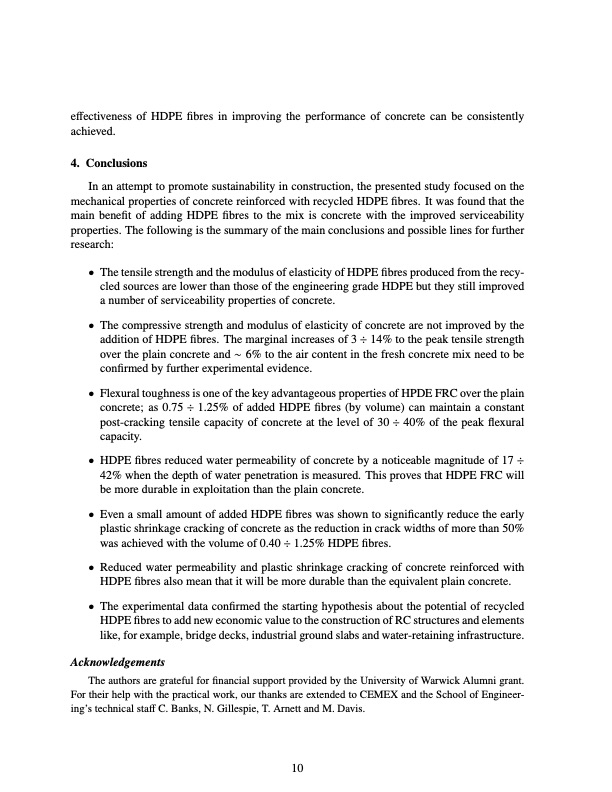
PDF Publication Title:
Text from PDF Page: 011
effectiveness of HDPE fibres in improving the performance of concrete can be consistently achieved. 4. Conclusions In an attempt to promote sustainability in construction, the presented study focused on the mechanical properties of concrete reinforced with recycled HDPE fibres. It was found that the main benefit of adding HDPE fibres to the mix is concrete with the improved serviceability properties. The following is the summary of the main conclusions and possible lines for further research: • The tensile strength and the modulus of elasticity of HDPE fibres produced from the recy- cled sources are lower than those of the engineering grade HDPE but they still improved a number of serviceability properties of concrete. • The compressive strength and modulus of elasticity of concrete are not improved by the addition of HDPE fibres. The marginal increases of 3 ÷ 14% to the peak tensile strength over the plain concrete and ∼ 6% to the air content in the fresh concrete mix need to be confirmed by further experimental evidence. • FlexuraltoughnessisoneofthekeyadvantageouspropertiesofHPDEFRCovertheplain concrete; as 0.75 ÷ 1.25% of added HDPE fibres (by volume) can maintain a constant post-cracking tensile capacity of concrete at the level of 30 ÷ 40% of the peak flexural capacity. • HDPE fibres reduced water permeability of concrete by a noticeable magnitude of 17 ÷ 42% when the depth of water penetration is measured. This proves that HDPE FRC will be more durable in exploitation than the plain concrete. • Even a small amount of added HDPE fibres was shown to significantly reduce the early plastic shrinkage cracking of concrete as the reduction in crack widths of more than 50% was achieved with the volume of 0.40 ÷ 1.25% HDPE fibres. • Reduced water permeability and plastic shrinkage cracking of concrete reinforced with HDPE fibres also mean that it will be more durable than the equivalent plain concrete. • The experimental data confirmed the starting hypothesis about the potential of recycled HDPE fibres to add new economic value to the construction of RC structures and elements like, for example, bridge decks, industrial ground slabs and water-retaining infrastructure. Acknowledgements The authors are grateful for financial support provided by the University of Warwick Alumni grant. For their help with the practical work, our thanks are extended to CEMEX and the School of Engineer- ing’s technical staff C. Banks, N. Gillespie, T. Arnett and M. Davis. 10PDF Image | Mechanical properties of concrete reinforced with recycled HDPE

PDF Search Title:
Mechanical properties of concrete reinforced with recycled HDPEOriginal File Name Searched:
concrete-reinforced-plastics.pdfDIY PDF Search: Google It | Yahoo | Bing
Development of a solar powered Electric Ship The Electricship website originally started off as a project to develop a comprehensive renewable, affordable, modular electric ship... More Info
Modular Boat Hull Composite The case for a unsinkable, modular composite hybrid boat hull... More Info
MS Burgenstock Hybrid Electric Catamaran Lake Lucerne Unique shuttle servicing Lucerne to the Burgenstock Resort... More Info
Ground Power Unit GPU Powered by Lithium Ion Batteries The goal of the Ground Power Unit is to provide a readily accessible, modular, ready-to-power solution for remote power... More Info
| CONTACT TEL: 608-238-6001 Email: greg@electricship.com | RSS | AMP |